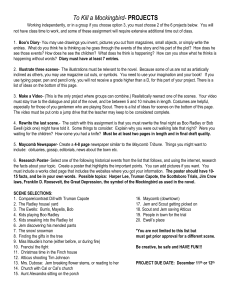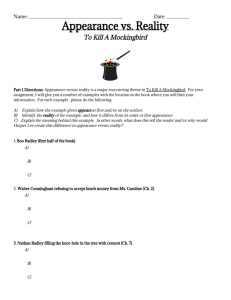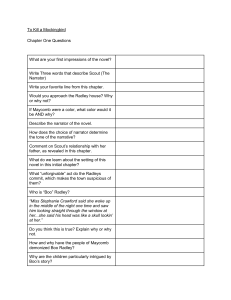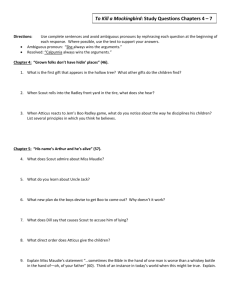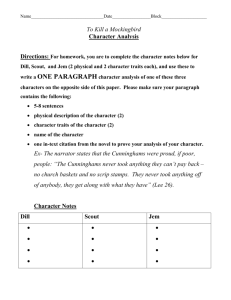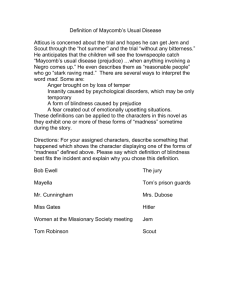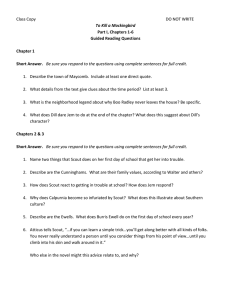Chapter 1 Stylistic Questions
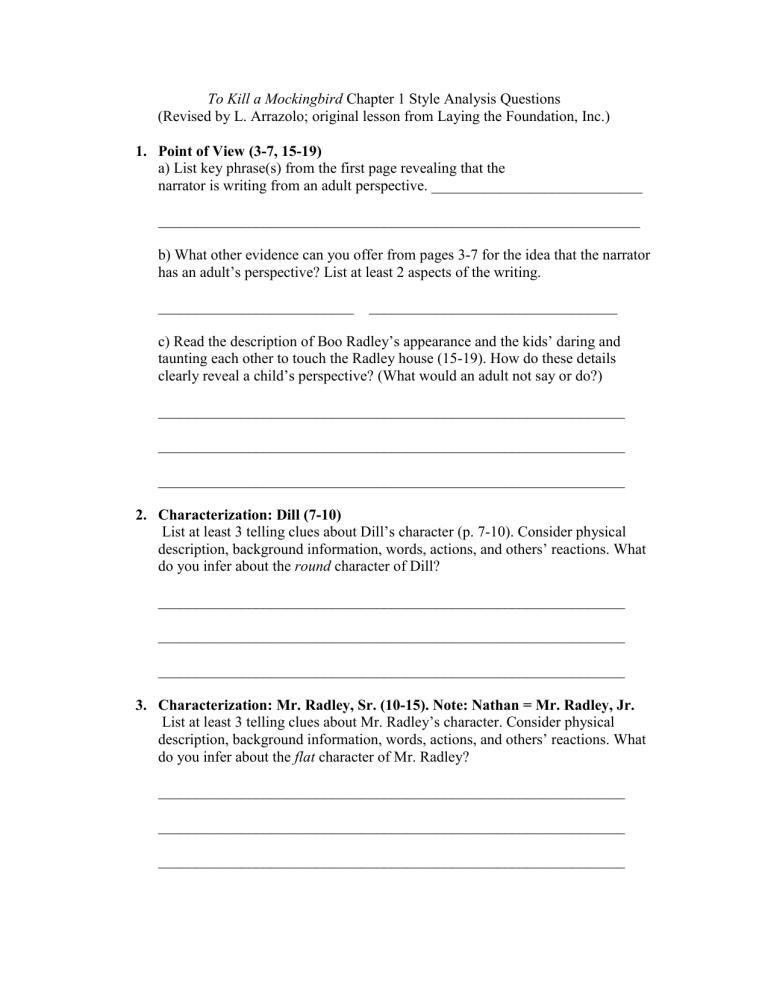
To Kill a Mockingbird Chapter 1 Style Analysis Questions
(Revised by L. Arrazolo; original lesson from Laying the Foundation, Inc.)
1.
Point of View (3-7, 15-19) a) List key phrase(s) from the first page revealing that the narrator is writing from an adult perspective. ____________________________
________________________________________________________________ b) What other evidence can you offer from pages 3-7 for the idea that the narrator has an adult’s perspective? List at least 2 aspects of the writing.
__________________________ _________________________________ c) Read the description of Boo Radley’s appearance and the kids’ daring and taunting each other to touch the Radley house (15-19). How do these details clearly reveal a child’s perspective? (What would an adult not say or do?)
______________________________________________________________
______________________________________________________________
______________________________________________________________
2.
Characterization: Dill (7-10)
List at least 3 telling clues about Dill’s character (p. 7-10). Consider physical description, background information, words, actions, and others’ reactions. What do you infer about the round character of Dill?
______________________________________________________________
______________________________________________________________
______________________________________________________________
3.
Characterization: Mr. Radley, Sr. (10-15). Note: Nathan = Mr. Radley, Jr.
List at least 3 telling clues about Mr. Radley’s character. Consider physical description, background information, words, actions, and others’ reactions. What do you infer about the flat character of Mr. Radley?
______________________________________________________________
______________________________________________________________
______________________________________________________________
4.
Characterization: Scout and Jem’s relationship (7-9, 17-19)
List at least 3 telling clues about Scout and Jem’s relationship as revealed in
Chapter 1. Consider words, actions, and reactions. What do you infer about the dynamic relationship between this brother and sister?
______________________________________________________________
______________________________________________________________
5.
Allusions a)
“Maycomb County had recently been told that it had nothing to fear but fear itself” (6). Do an online search to find out: Who made that statement?
What does this reference tell us?
______________________________________________________________ b) Look at bookdrum.com (search To Kill a Mockingbird) and find the pictures of the stories that Scout and Jem acted out (9-10). Highlight in orange these references in your book. Click on the links to learn more.
What kinds of stories were these?
______________________________________________________________
What does this tell us about Jem and Scout’s characters?
______________________________________________________________ c)
If Dill was a “pocket Merlin” (10), what kind of a friend was he?
______________________________________________________________
6.
Euphemism (a form of verbal irony)
Find these 2 euphemisms. Explain their literal meaning based on the context given in the book: a)
“disturbance between North and South” (4)
______________________________________________________________ b)
“bought cotton” (11)
______________________________________________________________
7.
Figurative Language
Identify the following examples as S simile, M metaphor, or P personification.
Circle or write to the side the 2 things being compared. a)
At night the women of Maycomb “were like soft teacakes with frostings of sweat and sweet talcum” (6).
b) Calpurnia was “all angles and bones” (6). c) “Mrs. Dubose was plain hell” (7). d) A picket fence “drunkenly guarded the front yard” (10). e)
“Inside the house lived a malevolent phantom” (10). f)
“tall pecan trees shook their fruit into the schoolyard” (11) g) From the day Arthur came home, “people said the house died” (15). h)
“The old house was the same, droopy and sick” (19)
8.
Ironic humor (also known as “dry” wit)
Find these humorous situations or expressions. Explain why they are ironic (capture some kind of twist or contrast). a)
“using…. profane language in the hearing and presence of a female” (12)
_______________________________________________________________ b) Besides, Boo could not live forever “on the bounty of the county” (14).
_______________________________________________________________ c)
Jem said he couldn’t disturb Boo because he “had his little sister to think of”
(17).
_______________________________________________________________
9.
Repetition and Parallelism : a) Underline the repeated words in the famous line below (6).
“Maycomb was an old town, but it was a tired old town when I first knew it.” b) For this line, underline nouns once and verbs twice. Note the parallel sets.
“ladies wore corsets, men wore coats, children wore shoes” (11) c) Find at least one more sentence in the section describing Maycomb (page 6) that exhibits parallelism. Write it here and underline the parallel sets of words:
_______________________________________________________________
